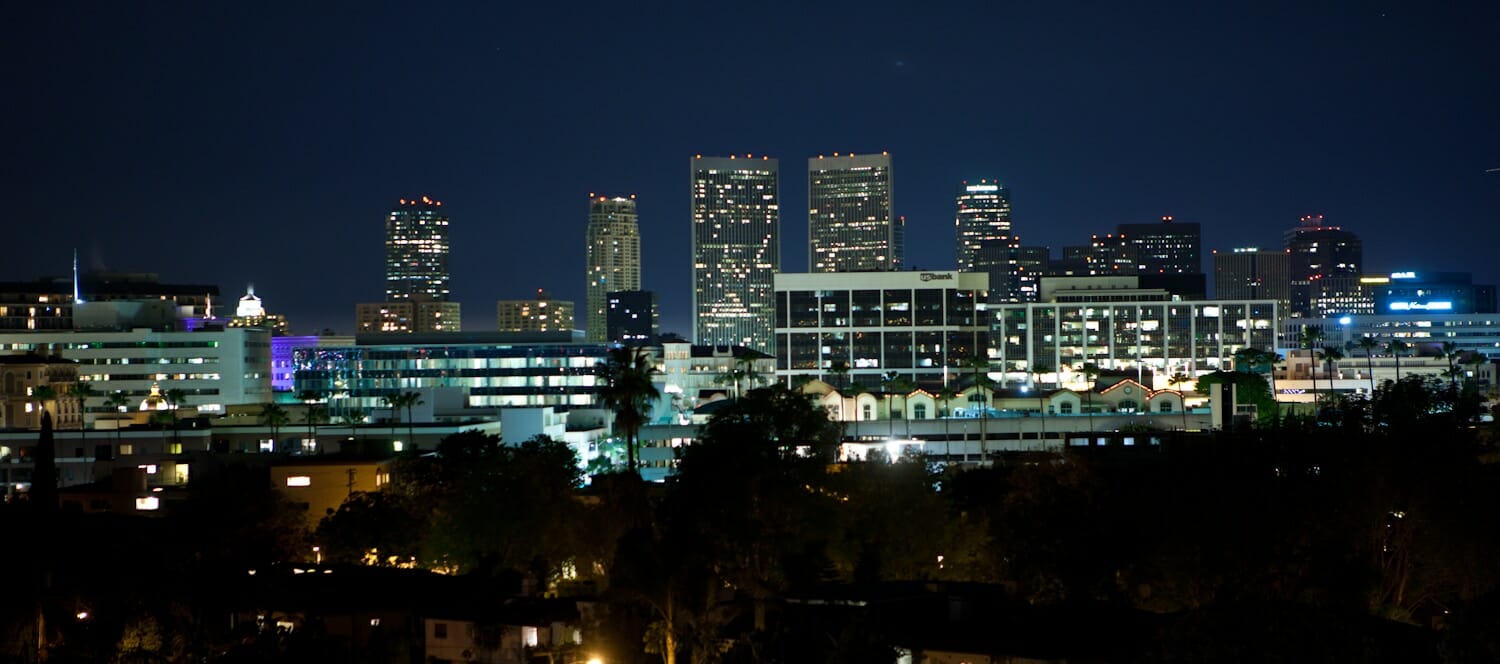In the early years of the 20th century, what is now Century City was open land owned by the silent cowboy movie star, Tom Mix. In 1925, Mix sold his private ranch to William Fox. It later became the backlot for 20th Century Studios that merged in 1935 with Fox Film Corporation.
The introduction of television to the consumer market in 1948 impacted the film industry and by 1950, studios had already lost a sizable share of their audience. In 1956, 20th Century Fox hired Edmond Herrscher as director of property development. Herrscher saw the possibility of selling parts of the back lot for business and commercial development and he coined the name “Century City” for Fox's back lot holdings.
Spyros Skouras, the president of 20th Century Fox, decided to repurpose a significant portion of the land for commercial real estate. In 1958, Welton Becket and Associates, one of Southern California's leading architectural firms, was hired to submit a financial analysis of Century City for possible development. They came up with a master plan that envisioned a “city within a city” with commercial, retail and residential space.
In May 1958, the decision to sell the property was made just as pre-production for “Cleopatra” began, even before its production cost overruns threatened to bankrupt the studio. “Cleopatra” was originally budgeted for $6 million, but by the time it was released in 1963, it had cost $37 million. While the spiraling production costs weren’t the reason for the sale, they added a sense of urgency.
In March 1959, after a series of unprofitable movies, Skouras sold much of the land to New York developer William Zeckendorf, who paid nearly $5 million for a six month option. Once the option went into effect, Zeckendorf turned around and unsuccessfully tried to raise the purchase price to $56 million, describing the property as "an oasis in the midst of a great city." In 1960, Zeckendorf signed an agreement to purchase the Fox property and develop Century City while leasing back 75 acres called the "studio portion" to Twentieth Century Fox.
Eighteen months later, the Aluminum Company of America, known as Alcoa, interested in diversifying its holdings outside the cyclical aluminum industry, offered $38 million for the property. In March 1961, after purchasing the property, Alcoa and Zeckendorf’s firm entered into a joint venture called Century City Inc. to market and develop the back lot.
The new venture, with Alcoa in the lead role, retained architect Welton Becket to oversee their Master Plan, which TIME magazine would later describe as a “modern Acropolis.” Becket envisioned super-blocks of carefully arranged and tastefully designed office, retail and residential structures.
Plans included 75 acres of residential units and 85 acres of commercial space. Becket’s design for the auto age featured wide boulevards including Avenue of the Stars, which was modeled after the Champs-Élysées, a pedestrian bridge and a large shopping center. To help Beckett realize his dream, he solicited the help of world-renown architects to design the look and feel of Century City: Minoru Yamasaki, Charles Luckman, I.M. Pei, Skidmore, Owings and Merrill and Albert C. Martin Associates.
Becket's Master Plan consisted of the careful allotment of land use, allowing 75 acres for residential development and 85 acres for business. The remaining 20 acres were devoted to streets and boulevards, and included the two water fountains constructed along Avenue of the Stars, the Automobile Club of Southern California's office building and a joint venture with I.M. Pei in designing The Century Tower Apartments, Century City's first major residential project.
The architect Minoru Yamasaki designed the Century Plaza Hotel, which opened in 1964.
In 1966, one of Century City’s most famous landmarks, the Century Plaza Hotel opened. Over the years it has hosted most of the U.S. presidents, including Richard Nixon, Ronald Reagan, and Joe Biden.
A few years later, ABC Entertainment Inc. opened a new entertainment complex that would eventually include the Schubert Theatre and a Playboy Club.
Alcoa built a set of two buildings that would become a showcase for its aluminum products, the 44-story triangular Century Plaza Towers were completed in 1975.
The steep recession of the early 1980s was a challenge to the aluminum market, so Alcoa sold its Century City holdings to JMB Realty Corporation in 1986. JMB continues to have a large footprint in Century City with 1999 Avenue of the Stars, Constellation Place, and 1950 Avenue of the Stars.
Century City is a vibrant, beautiful and safe "city within a city", making it one of the most valuable real estate markets in the U.S. as well as a destination neighborhood of Los Angeles. Century City companies include leading entertainment, law firms, banking, accounting, real estate, financial and professional services, and many other industries. Famous films such as Die Hard and Planet of the Apes have used this city as their backdrop, and movies and television programs continue to be made in this dynamic community.
Over the past 50 years, Century City has transformed into a vibrant city with culture, shopping, and businesses making it a destination stop within Los Angeles. More recently, CNN Money ranked 90067 as the 7th richest zip code in the country. Century City remains a link to the movie industry and old Hollywood. Famous films such as Die Hard and Planet of the Apes have used this city as their backdrop, and with Twentieth Century Fox's studios headquartered here, and other production companies, movies and television programs continue to be made in this dynamic community.
Be sure to check out this archived footage of a documentary on Century City that aired on KTLA in 1965:

For an in-depth look into the history of Century City, check out this extensive piece written by Craig Owens, this collection of historical photos of Century City, and this Historical Timeline. More information and the history of Century City: Century City - Wikipedia
https://planning.lacity.gov/eir/CenturyPlan/DEIR/issues/Appendix-C.pdf
